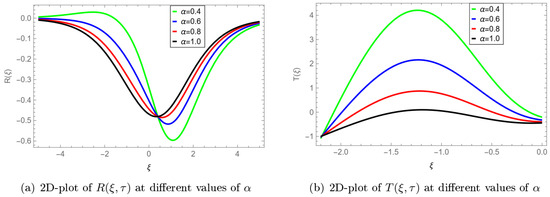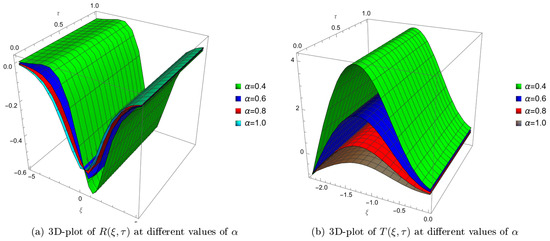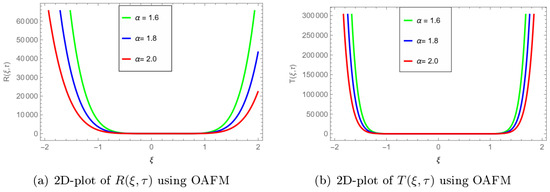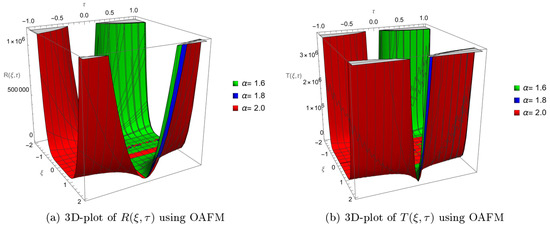Abstract
This paper introduces the optimal auxiliary function method (OAFM) for solving a nonlinear system of Belousov–Zhabotinsky equations. The system is characterized by its complex dynamics and is treated using the Caputo operator and concepts from fractional calculus. The OAFM provides a systematic approach to obtain approximate analytical solutions by constructing an auxiliary function. By optimizing the parameters of the auxiliary function, an approximate solution is derived that closely matches the behavior of the original system. The effectiveness and accuracy of the OAFM are demonstrated through numerical simulations and comparisons with existing methods. Fractional calculus enhances the understanding and modeling of the nonlinear dynamics in the Belousov–Zhabotinsky system. This study contributes to fractional calculus and nonlinear dynamics, offering a powerful tool for analyzing and solving complex systems such as the Belousov–Zhabotinsky equation.
Keywords:
optimal auxiliary function method; nonlinear system of Belousov–Zhabotinsky Equation; caputo operator; fractional calculus MSC:
26A33; 35J05; 387328; 65C30
1. Introduction
Fractional nonlinear systems of partial differential equations (PDEs) have garnered substantial research interest owing to their capacity to describe diverse phenomena across areas such as engineering, physics, and biology. Fractional derivatives, non-local operator that account for historical impacts, and complicated non-linearities are all part of these schemes. The usefulness of fractional calculus, which deals with fractional derivatives and integrals, has been demonstrated in real-world circumstances by simulating memory effects, long-range interactions, and anomalous diffusion. Simultaneously, nonlinear dynamics investigates the complicated behavior of complex systems that exhibit nonlinear interactions among their basic components [1,2,3]. The combination of these two domains has resulted in fractional nonlinear partial differential equation (PDE) systems capable of capturing the complicated dynamics found in several physical and biological systems. The analysis of fractional nonlinear PDE systems has provided a multitude of intriguing discoveries and practical applications within this rapidly developing field of study. Current research efforts are mostly focused on diving into the stability and bifurcation characteristics of solutions, as well as their uniqueness and existence, which is frequently supported by numerical simulations. These systems have been applied to a variety of disciplines, including fluid dynamics, electrochemistry, and population dynamics, each of which provides distinct insights and opportunities for investigation [4,5,6,7,8,9].
One class of nonlinear systems that has attracted significant attention is the nonlinear system of Belousov–Zhabotinsky equation (NSBZE). The NSBZE is a mathematical model that describes the complex behavior of reaction–diffusion systems exhibiting chemical oscillations and pattern formation. It finds applications in diverse areas such as chemistry, biology, and material science [10,11]. The nonlinear system of Belousov–Zhabotinsky equation, initially rooted in chemical reactions, has broadened its impact across multiple scientific domains. It is a cornerstone for understanding chemical kinetics, reaction–diffusion dynamics, and pattern formation. This equation finds applications in diverse fields, including materials science, biological systems, neural networks, artificial life, optics, and unconventional computing. Its insights inform the study of self-organizing materials, neural pattern formation, brain dynamics, and innovative information processing methods. Moreover, the equation’s visually captivating patterns and oscillations make it a valuable tool for educational outreach and fostering a deeper understanding of complex behaviors and nonlinear dynamics in various scientific contexts. To tackle the NSBZE, fractional calculus provides a powerful mathematical framework. Fractional calculus extends the concept of differentiation and integration to non-integer orders, allowing for analyzing systems with memory and long-range dependencies. The Caputo operator is commonly employed in fractional calculus, a fractional derivative operator widely used to describe the dynamics of physical systems governed by fractional differential equations [12,13,14,15,16,17].
The optimal auxiliary function method (OAFM) has proven to be a powerful tool for solving various types of nonlinear differential equations. This method introduces an auxiliary function that satisfies an ordinary differential equation optimized to yield approximate solutions for the original problem. The OAFM has been used effectively in various areas, including fluid dynamics, chemical reactions, and population dynamics [18,19,20,21]. In this paper, we aim to combine the optimal auxiliary function method with the Caputo operator in the context of the nonlinear system of Belousov–Zhabotinsky equation. We aim to develop an effective numerical technique for obtaining approximate solutions to this challenging nonlinear system. By utilizing the capabilities of the OAFM and the mathematical foundation provided by fractional calculus, we seek to enhance the accuracy and efficiency of the solution process.
2. Preliminaries
Definition 1.
The Caputo fractional derivative of a function with a fractional order α is expressed as [18]
Definition 2.
The expression for the Riemann fractional integral can be presented as follows [18]:
Lemma 1.
For , , and , we have [18]:
- 1.
- 2.
- 3.
- 4.
3. General Procedure of OAFM
In this section, we consider the most general type of a nonlinear fractional order differential equation [18]:
with the initial condition
where represents the fractional derivative of order , is the unknown function, and is the nonlinear function involving R, spatial variable , and time variable .
- Step 1: To solve Equation (3), we will use an approximate solution that has two components, such as:
- Step 3: For the purpose of determining the first approximation based on the linear equation.
Using the inverse operator, we arrive at , which is expressed as follows:
- Step 4: The nonlinear term seen in expanding form (6) is,
- Step 5: To quickly solve Equation (9) and accelerate the convergence of the first-order approximations , we propose the following alternative equation:
- Step 6: We find a first-order solutions by using the inverse operator after putting the Auxiliary function into Equation (10).
- Step 7: Several methods are used to find the numerical values of the convergence control parameters , including least squares, Galerkin’s, Ritz, and collocation. To eliminate mistakes, we employ the least squares approach.where ℜ denotes the residual,
4. Applications
4.1. Problem 1
Let us consider the Belousov–Zhabotinsky System of fractional order, which is represented by
Subject to the following IC’s:
Consider linear terms in Equation (13)
Consider nonlinear terms in Equation (13)
Zeroth-order approximation
By apply of the inverse operator, we obtain result as:
We choose the auxiliary function as:
First-order approximation using the OAFM approach, as described in Section 3.
using Equations (19) and (20) in Equation (21).
Using the inverse operator to Equation (22) we get
According to the OAFM procedure
In this discussion, we analyze the behavior of the Belousov–Zhabotinsky (BZ) system, as shown in Figure 1 and Figure 2. The BZ system is an example of a nonlinear chemical oscillator and is widely studied due to its oscillatory behavior, which can be observed in various fields such as biology, chemistry, and physics. We focus on the response functions and , which describe the behavior of the system under varying conditions. The parameter plays a crucial role in these response functions and is investigated in this discussion. Figure 1a presents a 2D plot of the response function at different values of the parameter . As the parameter increases, the plot illustrates the change in the oscillatory behavior of the BZ system. The response function exhibits more complex oscillatory patterns with increasing values of . This suggests that the parameter has a significant impact on the system’s response and can be used to control its behavior. Similarly, Figure 1b shows a 2D plot of the response function at different values of the parameter . The plot reveals that the oscillatory behavior of the BZ system also changes with varying values of in the case of . This further supports the idea that the parameter is a key factor in determining the overall behavior of the BZ system. To provide a more comprehensive understanding of the BZ system, Figure 2a,b display 3D plots of the response functions and , respectively, at different values of the parameter . These 3D plots offer a more detailed perspective on the complex oscillatory behavior of the BZ system. Figure 2a demonstrates how the 3D plot of the response function changes as the parameter is varied. The plot exhibits intricate patterns, indicating the complex relationship between , , and . Similarly, Figure 2b showcases a 3D plot of the response function at different values of . This plot also displays intricate patterns, further highlighting the significance of the parameter in the BZ system’s behavior. In Table 1 and Table 2, a comparison of the and OAFM solution and exact solution and their corresponding absolute error at fractional order where and for Problem 1. In conclusion, the graphical analysis of Figure 1 and Figure 2 clearly demonstrates that the parameter plays a crucial role in determining the behavior of the BZ system. The response functions and exhibit complex oscillatory patterns that change with varying values of . This analysis is beneficial for understanding and controlling the oscillatory behavior of the BZ system and other similar nonlinear chemical oscillators.

Figure 1.
The 2D-plots of and using the OAFM solution where and .

Figure 2.
The 3D-plots of and using OAFM solution where the values and .

Table 1.
A comparison of the OAFM solution and exact solution and their corresponding absolute error at fractional order where and for Problem 1.

Table 2.
Comparison of the OAFM solution and exact solution and their corresponding absolute error at fractional order for Problem 1.
The values of auxiliary constant obtained by collocation method.
, , and
4.2. Problem 2
Let us consider the system of a nonlinear fractional-order equation, which is represented by
Subject to the following IC’s:
Consider linear terms in Equation (25)
Consider nonlinear terms in Equation (25)
Zeroth-order approximation
By applying of the inverse operator, we obtain result as:
We choose the auxiliary function as:
First-order approximation using the OAFM approach, as described in Section 3.
using Equations (30) and (32) in Equation (33)
applying inverse operator to Equation (34) we get
According to the OAFM procedure
The values of auxiliary constant obtained by collocation method.
, , , , and
Figure 3 and Figure 4 present the graphical representations of the reflection, , and transmission, , coefficients obtained for a nonlinear fractional system of partial differential equations using the optimal amplitude frequency modulation (OAFM) method. Figure 3 illustrates the 2D plots of the coefficients: (a) represents the 2D plot of the reflection coefficient, , and (b) displays the 2D plot of the transmission coefficient, . The horizontal axis in both plots represents the spatial variable, , while the vertical axis represents the temporal variable, . The variation in color intensity indicates the magnitude of the coefficients. The 2D plots enable a clear visualization of the coefficients’ behavior with respect to the spatial and temporal variables, as well as how they change in the presence of nonlinearities. Figure 4, on the other hand, provides a more comprehensive representation of the coefficients through 3D plots. In this figure, (a) is the 3D plot of the reflection coefficient, , while (b) is the 3D plot of the transmission coefficient, . The horizontal plane represents the spatial variable, , and the temporal variable, . The vertical axis illustrates the magnitude of the coefficients. By using a 3D representation, it becomes easier to visualize the distribution of the coefficients and how they evolve in the nonlinear fractional system. Table 3 and Table 4 are a comparison of the OAFM solution and exact solution and their corresponding absolute error at fractional order for and for Problem 2. In conclusion, Figure 3 and Figure 4 offer a graphical representation of the reflection and transmission coefficients, and , for a nonlinear fractional system of partial differential equations using the OAFM method. The 2D and 3D plots allow for an in-depth understanding of the coefficients’ behavior and how they are affected by the nonlinearities present in the system.

Figure 3.
The 2D-plots of , using OAFM solution at different values of fractional order.

Figure 4.
The 3D-plots of , using OAFM solution at different values of fractional order.

Table 3.
A comparison of the OAFM solution and exact solution and their corresponding absolute error at fractional order for Problem 2.

Table 4.
A comparison of the OAFM solution and exact solution and their corresponding absolute error at fractional order for Problem 2.
5. Conclusions
In conclusion, the optimal Auxiliary function method (OAFM) has proven to be a powerful and effective technique for analyzing nonlinear systems, as demonstrated in this paper by applying it to the nonlinear system of the Belousov–Zhabotinsky equation. By utilizing the Caputo operator and concepts from fractional calculus, the OAFM provides a valuable approach to solving and understanding complex dynamic systems. The integration of Caputo operators further enhances the accuracy and authenticity of the model, enabling a more faithful representation of the underlying physical phenomena. The OAFM not only allows for accurate and efficient computations but also offers insights into the behavior and stability of the system. The results obtained using the OAFM highlight its effectiveness in addressing challenging problems in nonlinear dynamics. The combination of the OAFM, nonlinear systems, and fractional calculus opens up new avenues for future research, paving the way for further advancements and applications in various scientific and engineering domains.
Author Contributions
Conceptualization, A.S.A.; methodology, A.S.A.; software, H.Y.; validation, H.Y.; formal analysis, M.W.A.; investigation, M.W.A.; resources, A.K. and R.S.; data curation, A.K. and R.S.; Funding H.Y. All authors have read and agreed to the published version of the manuscript.
Funding
Princess Nourah bint Abdulrahman University Researchers Supporting Project number (PNURSP2023R183), Princess Nourah bint Abdulrahman University, Riyadh, Saudi Arabia. This work was supported by the Deanship of Scientific Research, the Vice Presidency for Graduate Studies and Scientific Research, King Faisal University, Saudi Arabia (Grant No. 4000).
Data Availability Statement
The numerical data used to support the findings of this study are included within the article. Mathematica codes for drawing the figures are available, which can be requested from R. Shah.
Acknowledgments
Princess Nourah bint Abdulrahman University Researchers Supporting Project number (PNURSP2023R183), Princess Nourah bint Abdulrahman University, Riyadh, Saudi Arabia. This work was supported by the Deanship of Scientific Research, the Vice Presidency for Graduate Studies and Scientific Research, King Faisal University, Saudi Arabia (Grant No. 4000).
Conflicts of Interest
The authors declare that there are no conflict of interest regarding the publication of this article.
References
- Alderremy, A.A.; Aly, S.; Fayyaz, R.; Khan, A.; Shah, R.; Wyal, N. The Analysis of Fractional-Order Nonlinear Systems of Third Order KdV and Burgers Equations via a Novel Transform. Complexity 2022, 2022, 4935809. [Google Scholar] [CrossRef]
- Iqbal, N. The fractional-order system of singular and non-singular thermo-elasticity system in the sense of homotopy perturbation transform method. Fractals 2023. [Google Scholar] [CrossRef]
- Mukhtar, S.; Noor, S. The numerical investigation of a fractional-order multi-dimensional Model of Navier-Stokes equation via novel techniques. Symmetry 2022, 14, 1102. [Google Scholar] [CrossRef]
- Alderremy, A.A.; Shah, R.; Iqbal, N.; Aly, S.; Nonlaopon, K. Fractional Series Solution Construction for Nonlinear Fractional Reaction-Diffusion Brusselator Model Utilizing Laplace Residual Power Series. Symmetry 2022, 14, 1944. [Google Scholar] [CrossRef]
- Alqhtani, M.; Saad, K.M.; Shah, R.; Weera, W.; Hamanah, W.M. Analysis of the Fractional-Order Local Poisson Equation in Fractal Porous Media. Symmetry 2022, 14, 1323. [Google Scholar] [CrossRef]
- Iqbal, N.; Chughtai, M.T.; Ullah, R. Fractional Study of the Non-Linear Burgers’ Equations via a Semi-Analytical Technique. Fractal Fract. 2023, 7, 103. [Google Scholar] [CrossRef]
- Jin, H.-Y.; Wang, Z.-A. Global stabilization of the full attraction-repulsion Keller-Segel system. Discret. Contin. Dyn. Syst. A 2020, 40, 3509–3527. [Google Scholar] [CrossRef]
- Li, H.; Peng, R.; Wang, Z.-A. On a Diffusive Susceptible-Infected-Susceptible Epidemic Model with Mass Action Mechanism and Birth-Death Effect: Analysis, Simulations, and Comparison with Other Mechanisms. SIAM J. Appl. Math. 2018, 78, 2129–2153. [Google Scholar] [CrossRef]
- Jin, H.-Y.; Wang, Z.-A. Boundedness, blowup and critical mass phenomenon in competing chemotaxis. J. Differ. Equ. 2016, 260, 162–196. [Google Scholar] [CrossRef]
- Epstein, I.R.; Pojman, J.A. An Introduction to Nonlinear Chemical Dynamics: Oscillations, Waves, Patterns, and Chaos; Oxford University Press: Oxford, UK, 1998. [Google Scholar]
- Karaagac, B.; Esen, A.; Ucar, Y.; Yagmurlu, N.M. A new outlook for analysis of Noyes-Field model for the nonlinear Belousov-Zhabotinsky reaction using operator splitting method. Comput. Math. Appl. 2023, 136, 127–135. [Google Scholar] [CrossRef]
- Prakash, A.; Kaur, H.; Rahul; Goyal, M. A Reliable Numerical Approach for Liouville-Caputo Time-fractional Belousov-Zhabotinsky Equation Arising in Chemical Oscillatory Reaction. In Control and Measurement Applications for Smart Grid: Select Proceedings of SGESC 2021; Springer Nature: Singapore, 2022; pp. 383–395. [Google Scholar]
- Akinyemi, L. A fractional analysis of Noyes–Field model for the nonlinear Belousov—Zhabotinsky reaction. Comput. Appl. Math. 2020, 39, 175. [Google Scholar] [CrossRef]
- Li, Q.; Lin, H.; Tan, X.; Du, S. H∞ Consensus for Multiagent-Based Supply Chain Systems Under Switching Topology and Uncertain Demands. IEEE Trans. Syst. Man, Cybern. Syst. 2020, 50, 4905–4918. [Google Scholar] [CrossRef]
- Wang, B.; Shen, Y.; Li, N.; Zhang, Y.; Gao, Z. An adaptive sliding mode fault-tolerant control of a quadrotor unmanned aerial vehicle with actuator faults and model uncertainties. Int. J. Robust Nonlinear Control. 2023. [Google Scholar] [CrossRef]
- Song, J.; Mingotti, A.; Zhang, J.; Peretto, L.; Wen, H. Accurate Damping Factor and Frequency Estimation for Damped Real-Valued Sinusoidal Signals. IEEE Trans. Instrum. Meas. 2022, 71, 6503504. [Google Scholar] [CrossRef]
- Ali, T.A.A.; Xiao, Z.; Jiang, H.; Li, B. A Class of Digital Integrators Based on Trigonometric Quadrature Rules. IEEE Trans. Ind. Electron. 2023, 1–11. [Google Scholar] [CrossRef]
- Liu, H.; Xu, Y.; Liu, J.; Chen, Y. Optimal Auxiliary Function Method for Fractional Differential Equations. J. Appl. Math. 2018, 2018, 1–13. [Google Scholar]
- He, J.-H. Optimal Auxiliary Function Method for Self-Adjoint Perturbed Nonlinear Problems. Nonlinear Sci. Lett. 2006, 1, 1–8. [Google Scholar]
- Chen, J.; Liu, Z.; Lomovtsev, F.E.; Obukhovskii, V. Optimal feedback control for a class of second-order evolution differential inclusions with Clarkes subdifferential. J. Nonlinear Var. Anal. 2022, 6, 551–565. [Google Scholar]
- Tang, Y. A characteristic mixed finite element method for bilinear convection-diffusion optimal control problems. J. Nonlinear Funct. Anal. 2022, 2022, 39. [Google Scholar]
Disclaimer/Publisher’s Note: The statements, opinions and data contained in all publications are solely those of the individual author(s) and contributor(s) and not of MDPI and/or the editor(s). MDPI and/or the editor(s) disclaim responsibility for any injury to people or property resulting from any ideas, methods, instructions or products referred to in the content. |
© 2023 by the authors. Licensee MDPI, Basel, Switzerland. This article is an open access article distributed under the terms and conditions of the Creative Commons Attribution (CC BY) license (https://creativecommons.org/licenses/by/4.0/).